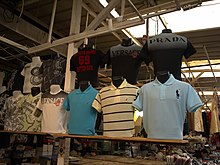
Back تقليد (تزوير) Arabic Saxtalaşdırma Azerbaijani Фальсіфікацыя Byelorussian Падробка BE-X-OLD Фалшификация Bulgarian Falsificiranje BS Falsificació Catalan Padělek Czech Falsado Esperanto Falsificación Spanish

A counterfeit is a fake or unauthorized replica of a genuine product, such as money, documents, designer items, or other valuable goods.[1][2][3] Counterfeiting generally involves creating an imitation of a genuine item that closely resembles the original to deceive others into believing it is authentic.[4]
Counterfeit products are often made to take advantage of the higher value of the original product, typically using lower-quality materials or production methods.[5] Counterfeit food, drinks, medicines, and personal care products can contain harmful or inactive ingredients, causing anything from mild issues to serious, life-threatening.[6][7][8][9] Counterfeit footwear, clothing, and accessories have been found to contain high levels of lead, arsenic, and phthalates.[10]
- ^ "counterfeit". LII / Legal Information Institute. Retrieved 2024-10-11.
A counterfeit is the fraudulent copy of money, documents, designer pieces, or other valuable items.
- ^ "WTO | Glossary - counterfeit". www.wto.org. Retrieved 2024-10-11.
Unauthorized representation of a registered trademark carried on goods identical or similar to goods for which the trademark is registered, with a view to deceiving the purchaser into believing that he/she is buying the original goods.
- ^ "WTO | intellectual property (TRIPS) - agreement text - enforcement". www.wto.org. Retrieved 2024-10-11.
(a) "counterfeit trademark goods" shall mean any goods, including packaging, bearing without authorization a trademark which is identical to the trademark validly registered in respect of such goods, or which cannot be distinguished in its essential aspects from such a trademark, and which thereby infringes the rights of the owner of the trademark in question under the law of the country of importation;
- ^ "Counterfeiting § 1". American Jurisprudence 2d. Vol. 20 (2nd ed.). West.
The term 'counterfeit' signifies the imitation of a genuine article having a resemblance intended to deceive and be taken for the original.
- ^ "Counterfeiting (Intended for a non-legal audience)". International Trademark Association. Retrieved 2024-10-12.
In simple terms, counterfeits are imitations of real products that are manufactured without approval from the owner of the brand. Counterfeit products are usually of substantially lower quality than the authentic goods and can even be dangerous, as they are often poorly made or made using dangerous or toxic chemicals and materials. Unfortunately, many well-known and successful companies, spanning just about every industry, fall victim to counterfeiting.
- ^ OECD/EUIPO (2022). Dangerous Fakes: Trade in Counterfeit Goods that Pose Health, Safety and Environmental Risks. Illicit Trade. Paris: OECD Publishing. doi:10.1787/117e352b-en. ISBN 978-92-64-34676-5.
Counterfeit food, beverages, pharmaceuticals and related personal care items which have been improperly formulated or which contain ingredients that are harmful can have effects ranging from mild inconveniences to consumers, to life-threatening situations. Moreover, in the case of pharmaceuticals, the lack of active ingredients can deprive consumers of the possibility to treat diseases effectively, thus prolonging illnesses that would otherwise be treatable.
- ^ Eban, Katherine (2024-06-04). "Why Counterfeit Ozempic Is a Global-Growth Industry". Vanity Fair. Retrieved 2024-10-13.
- ^ "Overdose deaths from fake pills are rising, especially among younger adults". NBC News. 2023-08-31. Retrieved 2024-10-13.
The CDC report, released to coincide with International Overdose Awareness Day, found that from mid-2019 to the end of 2021, overdose deaths involving counterfeit drugs more than doubled, from 2% to 4.7%.
- ^ Ahillan, Tharanika (2024-08-04). "Fifth of medicines in Africa may be sub-par or fake, research finds". The Guardian. ISSN 0261-3077. Retrieved 2024-10-13.
Estimates published last year by the UN Office on Drugs and Crime put the human cost of falsified and substandard medicines at up to 500,000 deaths a year in sub-Saharan Africa.
- ^ Wright, Beth (2022-03-24). "US counterfeit fashion goods contain dangerous chemicals". Just Style. Retrieved 2024-10-13.
A new study shows counterfeit fashion goods contain dangerous levels of chemicals and heavy metals, with 36.2% of counterfeit products tested – including clothing, footwear, and other accessories – failing to comply with US product safety standards.